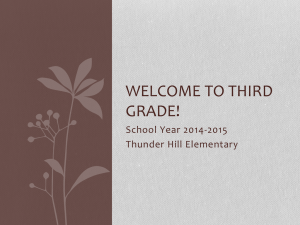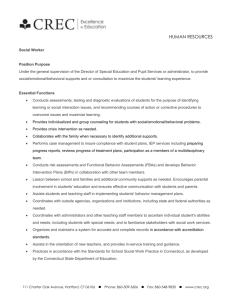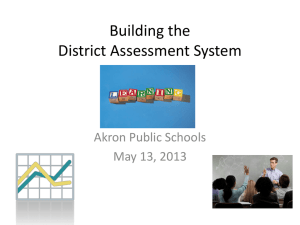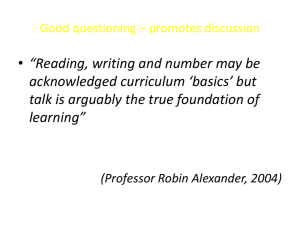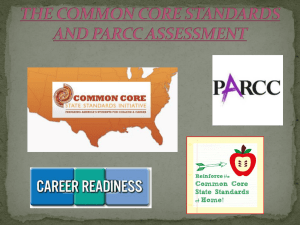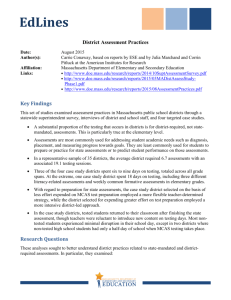Statewide Arts Education Priority - National Association for Music
advertisement
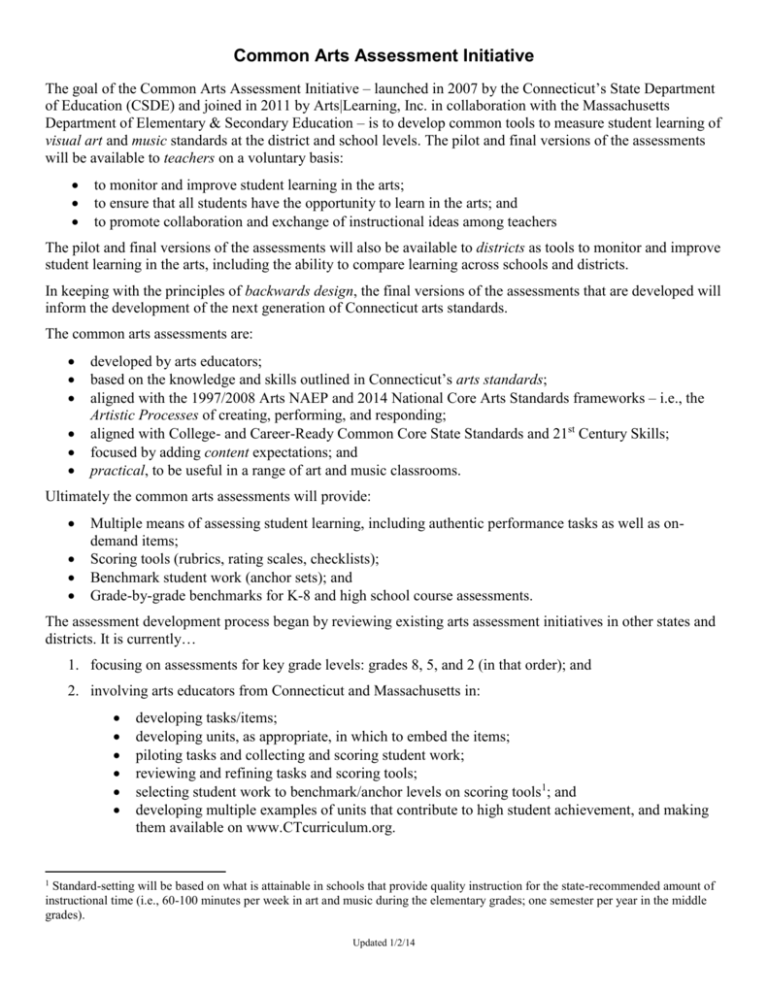
Common Arts Assessment Initiative The goal of the Common Arts Assessment Initiative – launched in 2007 by the Connecticut’s State Department of Education (CSDE) and joined in 2011 by Arts|Learning, Inc. in collaboration with the Massachusetts Department of Elementary & Secondary Education – is to develop common tools to measure student learning of visual art and music standards at the district and school levels. The pilot and final versions of the assessments will be available to teachers on a voluntary basis: to monitor and improve student learning in the arts; to ensure that all students have the opportunity to learn in the arts; and to promote collaboration and exchange of instructional ideas among teachers The pilot and final versions of the assessments will also be available to districts as tools to monitor and improve student learning in the arts, including the ability to compare learning across schools and districts. In keeping with the principles of backwards design, the final versions of the assessments that are developed will inform the development of the next generation of Connecticut arts standards. The common arts assessments are: developed by arts educators; based on the knowledge and skills outlined in Connecticut’s arts standards; aligned with the 1997/2008 Arts NAEP and 2014 National Core Arts Standards frameworks – i.e., the Artistic Processes of creating, performing, and responding; aligned with College- and Career-Ready Common Core State Standards and 21st Century Skills; focused by adding content expectations; and practical, to be useful in a range of art and music classrooms. Ultimately the common arts assessments will provide: Multiple means of assessing student learning, including authentic performance tasks as well as ondemand items; Scoring tools (rubrics, rating scales, checklists); Benchmark student work (anchor sets); and Grade-by-grade benchmarks for K-8 and high school course assessments. The assessment development process began by reviewing existing arts assessment initiatives in other states and districts. It is currently… 1. focusing on assessments for key grade levels: grades 8, 5, and 2 (in that order); and 2. involving arts educators from Connecticut and Massachusetts in: developing tasks/items; developing units, as appropriate, in which to embed the items; piloting tasks and collecting and scoring student work; reviewing and refining tasks and scoring tools; selecting student work to benchmark/anchor levels on scoring tools1; and developing multiple examples of units that contribute to high student achievement, and making them available on www.CTcurriculum.org. 1 Standard-setting will be based on what is attainable in schools that provide quality instruction for the state-recommended amount of instructional time (i.e., 60-100 minutes per week in art and music during the elementary grades; one semester per year in the middle grades). Updated 1/2/14 CT-MA Common Arts Assessment Page 2 Initiative Leadership and Contact Info CSDE arts consultant Dr. Scott C. Shuler oversees both the music and art common arts assessment initiatives, working in collaboration with discipline-specific project chairs. Contact: scott.shuler@ct.gov, (860) 713-6746. The music assessment initiative is chaired by Richard Wells, retired Simsbury Public Schools performing arts supervisor. Contact: tamrich@snet.net, (860) 485-1077. The visual arts assessment initiative was chaired for its first several years by Gail Edmonds, retired Middletown Public Schools visual arts coordinator. Contact: gpedmonds@yahoo.com. Draft tasks are linked and updated periodically on the arts education Web pages of the CSDE Web site: Standards, Guide, Common Assessments, Advocacy, Survey, etc. Timeline February 1, 2007 Connecticut Association of Arts Administrators (CAAA): The collaborating member districts of CAAA resolved that the Connecticut’s next statewide curriculum priority in arts education will be to develop common assessments to measure student art and music learning at the district and school levels. June 25-29, 2007 to Present: Ongoing series of summer arts curriculum and assessment institutes and workshops to train teachers in the use of existing common assessments and recruit developers for new assessments. 2007-08 School Year Steering Committees in art and music developed prototype performance tasks Teams of arts educators in steering committee districts refined and pre-piloted performance tasks for students in grades 5 and 8 Training on developing on-demand (selected response) items began 2008-09 School Year Piloted and refined first set of grade 5 and grade 8 tasks Developed and pre-piloted new grade 5 and 8 performance tasks in art and music, and two grade 2 music tasks 2009-10 School Year Field-tested and benchmarked 2 tasks in art and music (1 @ grades 5 and 8) Posted completed tasks with anchor sets on SDE arts Web site and CTcurriculum.org Pre-piloted and refined grade 8 Digital Media and grade 5 3-D Clay tasks in visual art 2010-11 School Year Piloted grade 8 Digital Media and 3-D Clay tasks in art Piloted and benchmarked grade 2, 5 and 8 music tasks and posted on CTcurriculum.org 2011-12 School Year (beginning of Connecticut-Massachusetts Partnership) Pilot grade 8 Digital Media and 3-D Clay tasks in art Develop music tasks for additional grade levels 2012-13 School Year Pilot and benchmark grade 8 Digital Media and 3-D Clay tasks in art Pre-Pilot new music tasks 2013-14 School Year Post grade 8 Digital Media and 3-D Clay tasks in art on CTcurriculum.org Pilot and benchmark additional music tasks updated 1/2/14 CT-MA Common Arts Assessment Page 3 Content of Assessments: Status and Plans Performance Tasks Performance tasks are designed as units with embedded assessment, to be administered and scored locally. Statewide standards are being established by refining common analytic and holistic rubrics, supported by benchmark (anchor sets of) student work illustrating levels of achievement from “emerging” to “advanced.” Creating Units/Tasks (includes student reflections and self-analysis) Music Grade 2 – Improvisation: duple meter call-and-response Music Grade 5 – Composition: 8 measures notated, with optional setting of text Music Grade 8 – Composition: ABA, highlighting unity/variety and tension/release Other grade levels – several tasks in piloting 2013-2014 Art Grade 5 – Fantasy Landscape: A Giant Just Stepped into a Fantasy World Art Grade 5 – 3-Dimensional Clay: Carving a Narrative in Pottery Art Grade 8 – Self-portrait: Incorporating Personal Symbols, in Mixed 2-Dimensional Media Art Grade 8 – Digital Media: Narrative Collage In all Creating tasks students plan, describe, analyze, and reflect on their own work Performing Units/Tasks Music Grades 2, 5, and 8 – Singing (will develop future instrumental performing task for grade 8) Other grade levels: several tasks in piloting 2013-2014 In all Singing tasks students self-critique; beginning in the intermediate grades, students also write recommendations for improving their own work Responding Components are included in Creating and Performing Units/Tasks Description: using academic (Tier 3) vocabulary to describe art works accurately Analysis: moving from description to understanding Classification, citing supporting evidence Interpretation, citing supporting evidence Critique artwork and identify appropriate recommendations for improvement Measurement of responding will be built into on-demand assessment (see below) On-Demand Items On-demand items will complement Responding elements embedded in Creating and Performing Units/Tasks. Ultimately, on-demand items will be administered on-line, in at least grades 5 and 8. Content will be based on a content matrix that outlines key components such as: Media Subject Matter Arts Creators (composers, choreographers, visual artists, playwrights) Movements Historical Periods and Cultures Content may be either based around or built into one or more model art and music guides that are provided for districts’ voluntary use. updated 1/2/14
